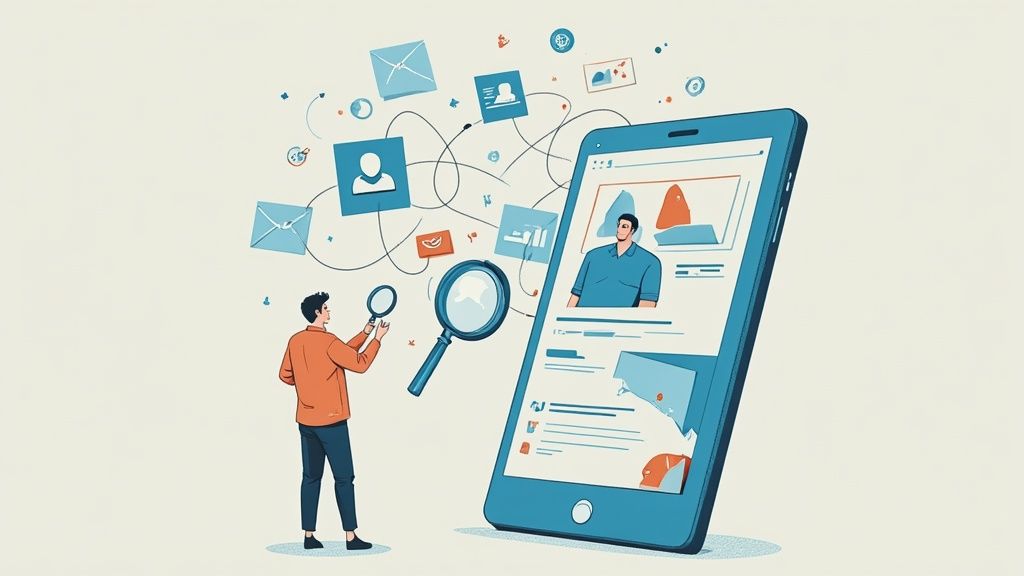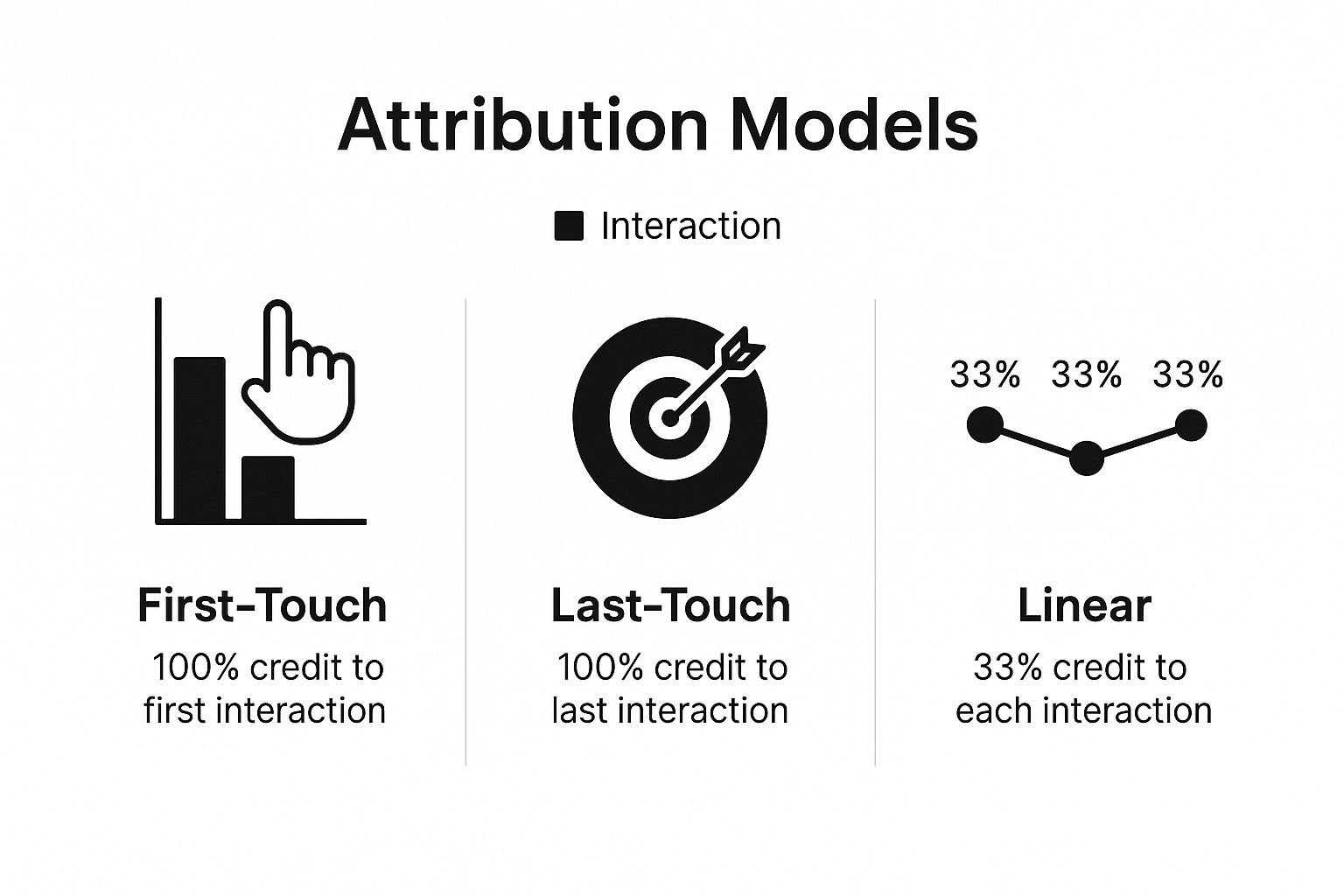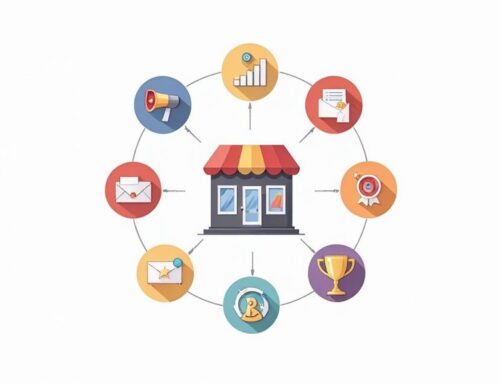Think of marketing attribution as the practice of connecting the dots. It’s how you figure out which of your marketing efforts—every ad, email, social post, and blog article—actually convinced a customer to make a purchase. Essentially, it links your marketing actions directly to real revenue.
Why Marketing Attribution Is a Game Changer

Let’s use a sports analogy. Imagine your marketing channels are players on a soccer team: you have paid search, social media, content, and email all working together. When your team scores a goal (a conversion), who gets the credit? Is it just the striker who kicked the ball into the net? What about the midfielder who made the perfect pass, or the defender who started the entire play?
Without proper analysis, you might only credit the final goal-scorer. This is exactly what happens when businesses only track the last touchpoint before a sale. Marketing attribution is your post-game breakdown, showing you how every single player—every marketing touchpoint—contributed to the win. It helps you move past guesswork and into data-driven decisions.
Moving Beyond Simple Metrics
At its heart, marketing attribution is about understanding the modern customer journey. People rarely see one ad and buy instantly. Their path is often winding, involving multiple touchpoints across different platforms over days or even weeks.
Think about a typical customer’s journey:
- They first discover your brand through a post on LinkedIn.
- A week later, they search for your company on Google and browse your site.
- They sign up for your newsletter and open a few emails.
- Finally, they click a retargeting ad on Facebook and make a purchase.
An attribution model assigns credit to each of these steps, not just the final click. This is where the magic happens. These insights are crucial for making smarter decisions about where to put your time, money, and effort. You can finally show the value of those top-of-funnel activities that build awareness, not just the bottom-of-funnel ones that seal the deal.
Key Takeaway: Marketing attribution gives you the hard evidence to justify your marketing spend and fine-tune your entire strategy. It changes the conversation from, “I think this channel is working,” to, “I know this channel drives X% of our revenue.”
Implementing a solid attribution strategy offers a massive advantage. Instead of flying blind, you can allocate your budget with confidence, sharpen your messaging, and truly get inside your customers’ heads.
The benefits aren’t just theoretical; they have a direct impact on your bottom line. Below is a breakdown of the key advantages.
Key Benefits of Marketing Attribution
| Benefit | Business Impact |
|---|---|
| Optimized Marketing Spend | Allocate budget to the channels and campaigns that deliver the highest return on investment (ROI), eliminating wasteful spending. |
| Improved Campaign Performance | Identify which content, messages, and touchpoints resonate most with your target audience at each stage of their journey. |
| Deeper Customer Insights | Understand the complete path to purchase, revealing how different customer segments interact with your marketing efforts. |
| Accurate ROI Measurement | Justify marketing investments by demonstrating a clear, data-backed link between specific activities and revenue generation. |
Ultimately, adopting marketing attribution means you stop guessing and start knowing what truly moves the needle for your business.
The Journey From Broad Strokes To Pixel-Perfect Insights

To really get what marketing attribution is all about, you have to look at where it came from. For decades, long before we had any sort of digital analytics, marketers had a huge problem. How could they possibly prove that their expensive TV, radio, and print campaigns were actually working? They had to find a way to connect those big, splashy ads to actual sales, moving beyond gut feelings to something a bit more concrete.
This is where the first real attempts at attribution began. The concept really started to take shape in the mid-20th century with something called Media Mix Modeling (MMM), which became popular in the 1980s. MMM used high-level stats to figure out how much each advertising channel—like TV or print—was contributing to sales. It was the best tool they had for deciding where to put their massive ad budgets.
The problem? MMM painted with a very broad brush. It might tell you that your TV ads were doing well in general, but it couldn’t follow a single person from seeing a commercial to buying your product. It was a 10,000-foot view when marketers were starting to crave a map of the individual streets.
The Digital Age And The Last-Click Problem
Then the internet happened, and it changed everything. All of a sudden, marketers could track every click, every page view, every form fill. This massive wave of data gave birth to a much simpler way of measuring what worked, but it came with a huge, glaring flaw.
This was the era of last-click attribution, which quickly became the standard for early web analytics. The idea was simple: whatever a person clicked right before they converted got 100% of the credit. So, if someone clicked a Google ad and then bought something, Google Ads got all the glory. That blog post they read a week ago? The social media ad they saw yesterday? Completely ignored.
It was like giving the game-winning trophy to the basketball player who scored the final basket, while completely forgetting the rest of the team who passed, defended, and set up the shot in the first place.
Last-click attribution created a distorted view of marketing effectiveness, heavily favoring bottom-of-the-funnel activities while undervaluing the crucial top-of-funnel channels that introduce and nurture potential customers.
This oversimplification caused real problems. Companies started funneling all their money into channels that were great at closing, while starving the very activities that got people interested to begin with. Marketers knew their content and social media were valuable, but last-click attribution made it impossible to prove. The growing gap between marketing efforts and sales results highlighted a need for better collaboration, which is a challenge you can explore in our guide on proven tactics for marketing and sales alignment.
This major blind spot was the real driver for change. Marketers needed to see the entire customer journey, not just the final play. This demand for a fuller, fairer picture is what led to the sophisticated multi-touch attribution models we have today.
Single-Touch vs. Multi-Touch Attribution: What’s the Difference?
When you first dip your toes into marketing attribution, you’ll immediately run into two main schools of thought: single-touch and multi-touch. Getting a handle on how these two approaches work is the first real step toward building a strategy that gives you clear insights, not a funhouse mirror reflection of your marketing efforts.
Think of it like a relay race. A single-touch model gives the gold medal to just one runner—either the one who started the race or the one who crossed the finish line. Multi-touch, on the other hand, recognizes that the whole team worked together to win. Each approach tells a wildly different story.
The Simplicity (and Blind Spots) of Single-Touch Models
Single-touch models are exactly what they sound like. They give 100% of the credit for a sale to just one marketing interaction. Their biggest selling point is simplicity; they’re easy to set up and even easier to understand, which is why they were the standard for so long.
The two you’ll see most often are First-Touch and Last-Touch.
- First-Touch Attribution: This model gives all the credit to the very first time a customer ever interacted with your brand. It’s like saying the person who first introduced you to your future spouse deserves all the credit for your marriage. It’s fantastic for seeing what brings people to your front door, but it completely ignores the entire relationship you built afterward.
- Last-Touch Attribution: This one does the opposite, giving all the credit to the final touchpoint before a customer buys. Imagine giving a high-five only to the salesperson who got the signature on the dotted line, ignoring the months of marketing work that warmed up the lead. It’s useful for pinpointing what finally seals the deal, but it overlooks the crucial journey that got them there in the first place.
The glaring problem with any single-touch model is the massive blind spots it creates. By zeroing in on just one moment, you miss the full, nuanced story of how a customer actually makes a decision. This can lead to some really bad budget calls, like slashing your top-of-funnel channels because they aren’t “closing,” when in reality, they’re the ones keeping your pipeline full.
Seeing the Full Picture with Multi-Touch Attribution
This is where multi-touch attribution comes in as a much more sophisticated and realistic solution. Instead of crowning a single hero, it acknowledges that a whole series of touchpoints played a part in a conversion. It’s a team sport, and every player’s contribution matters.
Multi-touch attribution spreads the credit across multiple interactions in the customer journey. This gives you a more balanced and honest view of how all your marketing channels work together to drive real business results.
Let’s map out a common customer journey:
- They discover your brand through a Google search.
- They follow your company page on LinkedIn and see a few of your updates.
- They get a nurturing email from you with a helpful case study.
- A week later, they click a retargeting ad and finally make a purchase.
A multi-touch model would assign a piece of the credit to all four of those interactions. This way, you can actually see the value in each step—from the initial search that started it all to the final ad that pushed them over the edge. It proves the worth of your blog content, your social media game, and your email campaigns, not just the last click.
Once you start looking at your marketing this way, you can finally connect the dots and understand the true ROI of your entire marketing mix.
Let’s face it: single-touch models are simple, but they just don’t tell the whole story. The modern customer journey is a winding road, not a straight line. This is where multi-touch attribution really proves its worth. Instead of pinning a gold medal on a single “hero” touchpoint, multi-touch models recognize that a sale is almost always a team effort.
These models distribute credit across the various interactions a customer has with your brand, giving you a much more realistic and balanced picture of what’s actually working. Think of it less like a 100-meter dash and more like a relay race—every runner, and every handoff, is critical to crossing the finish line. If you’re serious about making smart, data-informed marketing decisions, you need to look beyond that one final click.
This image gives a great at-a-glance comparison of how different models assign credit. You can see how the single-touch models create an all-or-nothing scenario, while a multi-touch approach acknowledges the steps in between.

As the visual shows, a linear model ensures those valuable mid-journey touchpoints don’t get lost in the shuffle, which is a common pitfall of giving all the credit to the first or last interaction.
The Linear Model
The Linear model is the most democratic of the bunch. It’s built on a simple premise: every single touchpoint gets an equal slice of the pie.
So, if a customer read a blog post, saw a social ad, opened two emails, and then clicked a retargeting ad before buying, each of those five interactions would get exactly 20% of the credit. It’s fair, balanced, and a fantastic starting point for understanding the full journey.
- Who it’s for: Businesses that want a baseline view of how all their channels contribute. It’s a great choice if you value every interaction and want to maintain consistent engagement from start to finish.
- The catch: Its strength is also its weakness. A quick, casual website visit gets the same weight as a high-intent demo request. This can make it tough to spot which specific touchpoints are really punching above their weight and driving conversions.
The Time Decay Model
The Time Decay model adds a dose of reality by factoring in timing. It still gives credit to all touchpoints, but the ones that happen closer to the final conversion get a much bigger share.
Picture a customer journey that unfolds over a few weeks. The social media ad they saw on day one gets a little credit, but the promo code email they clicked just an hour before checkout? That gets a huge chunk. The credit essentially “decays” the older an interaction gets.
This model often works on a 7-day half-life. An interaction from eight days ago would get half the credit of an interaction from yesterday.
- Who it’s for: A perfect fit for companies with longer sales cycles, like B2B tech or high-end retail. It’s also incredibly useful for e-commerce brands running flash sales or seasonal promos, as it highlights the touchpoints that successfully created urgency and sealed the deal.
- The catch: Because it’s so focused on what happened recently, it can seriously undervalue those crucial top-of-funnel activities. That brilliant awareness campaign that first introduced someone to your brand might get almost no credit, even though the journey never would have started without it.
The Position-Based (U-Shaped) Model
The Position-Based model, also known as the U-Shaped model, is more strategic. It places the most importance on two pivotal moments: the very first touchpoint (the introduction) and the very last one (the closer).
In a typical setup, this model gives 40% of the credit to the first touch, 40% to the last touch, and then splits the remaining 20% across all the interactions in the middle. This hybrid approach is popular because it honors both the channel that brought in the lead and the one that converted them. This is especially useful in complex B2B markets where building relationships over time is key, though it can sometimes downplay the nurturing that happens in between. For a more detailed look, you can explore the nuances of cross-channel attribution.
- Who it’s for: Organizations that value both lead generation and closing tactics equally. If your strategy hinges on great top-of-funnel content to hook prospects and effective bottom-of-funnel offers to convert them, this model gives you a balanced view.
- The catch: Those middle-of-the-funnel touchpoints—the nurturing emails, the helpful case studies, the social media engagement—get very little love. This can make it difficult to prove the ROI of your mid-funnel efforts, even when they’re essential for keeping leads warm.
Comparing Multi-Touch Attribution Models
To make sense of these options, it helps to see them side-by-side. Each model tells a different story about your customer’s journey, and the best one for you depends entirely on what questions you’re trying to answer.
| Model | How It Works | Best For | Potential Weakness |
|---|---|---|---|
| Linear | Distributes credit equally across all touchpoints in the journey. | Getting a holistic baseline view of all channel performance. | Treats all interactions as equally important, masking high-impact touchpoints. |
| Time Decay | Gives more credit to touchpoints that occur closer in time to the conversion. | Businesses with longer sales cycles or short, intense marketing campaigns. | Can undervalue crucial top-of-funnel activities that started the journey. |
| Position-Based (U-Shaped) | Assigns most credit (40% each) to the first and last touchpoints, with the rest (20%) split among the middle touches. | Teams that prioritize both lead generation and conversion-closing equally. | Minimizes the perceived value of essential mid-funnel nurturing efforts. |
Ultimately, there’s no single “perfect” model. The right choice depends on your business goals, the length of your sales cycle, and the story you want your data to tell. By understanding the strengths and weaknesses of each, you can pick the one that best reflects how your customers genuinely interact with your brand.
Building Your Marketing Attribution Strategy
Alright, so you understand what marketing attribution is. Now comes the fun part: making it work for you. Moving from grasping the concepts to actually implementing a strategy can feel like a huge leap, but it’s not as daunting as it sounds.
Think of it less like a single, giant task and more like a series of deliberate choices. A solid attribution strategy isn’t about flipping a switch; it’s about building a framework, piece by piece, that fits your specific business.
H3: First Things First: Define Your Goals and Key Conversions
Before you even glance at a tool or a model, you have to answer the most important question: what are we actually trying to achieve here? What does a “win” look like for your business? This “win” is your conversion.
And spoiler alert: it’s rarely just about the final sale. A conversion is any meaningful action a person takes that signals they’re moving down the path to becoming a customer.
Your list of key conversions is the North Star for your entire strategy. For example:
- If you run an ecommerce store: A conversion might be a completed purchase, of course, but it could also be someone adding an item to their cart or signing up for a 10% off coupon.
- If you’re a B2B SaaS company: You’re probably tracking demo requests, free trial sign-ups, or downloads of a key piece of content like a whitepaper.
- If you’re a publisher: Your wins might be a newsletter subscription or getting someone to register for a webinar.
By clearly defining your conversion goals, you give your attribution strategy purpose. You’re no longer just tracking clicks; you’re measuring progress toward tangible business objectives.
Once your main goals are set, you can identify the “micro-conversions”—the smaller steps that lead up to the big ones. These are the breadcrumbs of the customer journey, and they’re essential for any multi-touch model. Nailing this down is a huge part of figuring out how to measure marketing campaign success.
H3: Next, Get Your Data House in Order
Let me be blunt: your attribution model is only as good as the data you feed it. If your data is a mess—inconsistent, incomplete, or just plain wrong—your insights will be worthless. You’ll end up making bad decisions based on bad information. This is why data hygiene is non-negotiable.
The biggest culprit of messy data? An inconsistent UTM parameter strategy. UTMs are the simple tags you add to your URLs to tell your analytics platform where traffic is coming from. If your team isn’t on the same page, chaos ensues.
For instance, if one marketer tags a paid social campaign source as “facebook” and another uses “Facebook-Ad,” your analytics tool sees two completely different sources. Your data gets fractured, and your ability to attribute accurately is destroyed. You need a documented, company-wide system for UTM tagging that everyone follows. No exceptions.
H3: Finally, Choose the Right Tools for the Job
With clear goals and a plan for clean data, you can finally start looking at tools. The market is full of options, ranging from free and simple to incredibly powerful (and expensive).
- The Starting Line (e.g., Google Analytics): This is where most people begin, and for good reason. GA provides basic attribution models like First-Click, Last-Click, and Linear right out of the box. For businesses with simpler sales cycles, it can offer a ton of value without any extra cost.
- The Heavy Hitters (e.g., Advanced Attribution Platforms): When things get more complex, you need more firepower. Tools like HockeyStack, HubSpot, or a dedicated customer data platform (CDP) are built for the tough stuff. They shine when tracking long, multi-touch B2B sales cycles, connecting online and offline data, and offering far more sophisticated modeling.
The “right” tool really depends on your business. An ecommerce brand might get everything it needs from a Time-Decay model in Google Analytics. But a B2B enterprise with a nine-month sales cycle needs a more robust, account-based platform to see the whole story. The goal is to match the tool’s capabilities to the reality of your customer journey.
Attribution in Action with Real-World Examples

Theory is one thing, but the real magic of marketing attribution happens when it solves actual business problems. This is where you move from making educated guesses to making data-backed decisions that genuinely boost your bottom line. The secret lies in picking the right model for the right challenge.
Let’s walk through a couple of different scenarios to see exactly how this works. These examples show how different businesses use attribution to find those “aha!” moments and drive real growth.
Ecommerce Success With The Time Decay Model
Picture an online store heading into the chaotic holiday shopping season. They’re running everything: social media ads, influencer partnerships, Google Shopping campaigns, and a flurry of promotional emails. For years, they’ve used last-click attribution, which always made their final “Last Chance for 25% Off!” email look like the hero of the entire quarter.
But the marketing team felt that couldn’t be the whole story. So, they decided to switch to a Time Decay model to get a clearer picture.
The Time Decay model is a multi-touch approach that assigns more credit to the touchpoints that happen closer to the sale. It still gives some credit to the early interactions that got the ball rolling, but it heavily favors the more recent ones. This makes it perfect for campaigns with a defined start and end date, like a holiday sale.
The results were a wake-up call. The model showed that yes, the last-minute email was definitely a heavy hitter. But it also highlighted that their “Holiday Gift Guide” blog post and an Instagram influencer campaign from early December were doing a lot of the initial heavy lifting. These early touchpoints were planting the seeds, even if they didn’t get the final click.
Armed with this new insight, the brand invested more in their top-of-funnel content the following year. The result? A 15% increase in overall holiday revenue.
B2B Growth With The Position-Based Model
Now, let’s switch gears to a B2B SaaS company. Their sales cycle is long—we’re talking six to nine months. The marketing team produces amazing, high-value content like in-depth industry reports and webinars, but they have a tough time proving its value. Meanwhile, the sales team gets all the glory because their product demos are the last step before a contract is signed.
To fix this disconnect, they brought in a Position-Based (or U-Shaped) model. This model gives 40% of the credit to the very first touchpoint, 40% to the final one (the demo request), and spreads the last 20% across all the interactions in between.
The impact was immediate and powerful. The U-shaped model clearly demonstrated that their thought-leadership content was the single most important source for generating new, qualified leads. It proved the blog wasn’t just a side project but a core engine for pipeline growth. This hard data gave the marketing team the proof they needed to secure a bigger content budget, which directly led to a 20% year-over-year increase in qualified leads.
Answering Your Top Marketing Attribution Questions
When you first dive into marketing attribution, a few questions always seem to pop up. It can feel like a complex world from the outside, but once you break down these common queries, you see just how practical it is. Let’s tackle some of the biggest questions head-on.
What Is the Best Marketing Attribution Model?
This is the million-dollar question, and the real answer is… there isn’t one. The “best” model is the one that actually fits your business. It all comes down to your goals, how long it takes for a customer to buy from you, and what you’re trying to figure out.
- An ecommerce brand holding a flash sale might find a Time Decay model works perfectly. It gives more credit to the recent emails and ads that pushed someone to buy right now.
- On the other hand, a B2B software company with a six-month sales cycle would get more value from a Position-Based (U-Shaped) model. This approach rightly values both the first blog post that got them interested and the final demo that sealed the deal.
The goal isn’t to chase some mythical, one-size-fits-all model. It’s about picking the one that tells the most accurate story about your customer’s journey so you can make smarter decisions.
How Can I Start With Attribution on a Small Budget?
Good news: you don’t need to sign a massive check for an enterprise-level platform to get started. You can pull some incredibly useful insights from free or low-cost tools, as long as you have a focused approach.
Start with the tools you already have. Google Analytics offers several attribution models—like First-Click, Last-Click, and Linear—straight out of the box. This gives you a solid starting point for understanding how your channels work together, all without spending an extra dime.
Kick things off with a simple model like Linear to get a baseline read on all your touchpoints. The most important thing at this stage is to make sure your UTM tracking is clean and consistent. Good data in a simple model is far more valuable than messy data in a complex one.
How Does Attribution Handle Both Online and Offline Channels?
Connecting digital clicks with real-world handshakes is definitely one of the trickier parts of attribution, but it’s entirely possible. It just takes a commitment to gathering data consistently and linking your systems together.
For offline touchpoints—think trade shows, sales calls, or even direct mail—your team needs a clear, standardized process for getting that information into your CRM. For example, every sales rep has to log every call and meeting and tie it to the right contact record. This manual effort, combined with your automated online tracking, helps you build a complete picture of the journey, finally connecting that in-person demo back to the blog post they read six months ago.
At ReachLabs.ai, we specialize in building data-driven strategies that connect every touchpoint to your bottom line. Our team helps you move past the guesswork to get clear insights on what’s actually working, so you can optimize your spend and grow faster. Find out how our collective approach can elevate your marketing by visiting us at https://www.reachlabs.ai.





